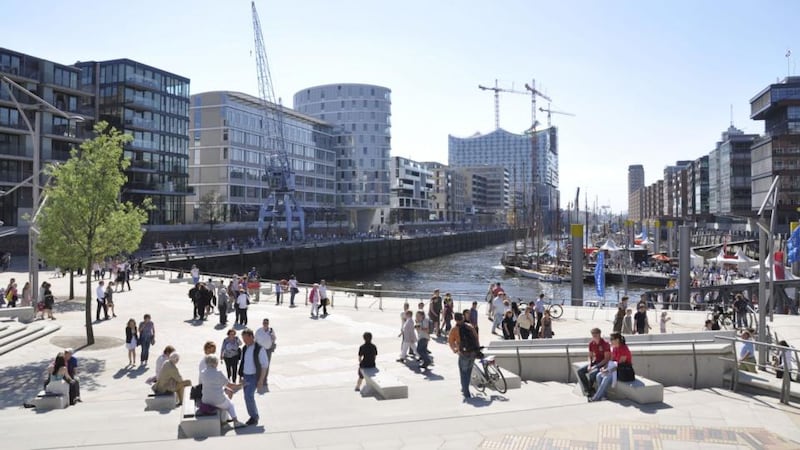On Hamburg’s Reeperbahn, a trashier cousin of New York’s Times Square circa 1997, Saturday has just turned to Sunday. As befits a notorious entertainment strip, the neon is flashing, the theatres are letting out, and the prostitutes are putting out.
Standing on street corners, the working womens’ methods range from the direct (“You horny?”) to the creative: a young bottle-blonde lays a firm hand on my upper arm and asks: “Just a moment, please, out of politeness.”
There’s so much going on over your average Reeperbahn evening that even a jaded visiting Berliner can feel like a country bumpkin. And with almost two million people, Germany’s second-largest city often shows off a bigger city vibe than the capital.

One reason is that Berlin's identity has always been inward-looking, its residents convinced they are the bellybutton of the world. Hamburg residents are different, their eyes fixed on the horizon, confident their city is a gateway to the world. Dublin has Guinness but Hamburg has two elixirs: Astra beer and the sea.
Sit at sunset on the Landungsbrücke, looking out over the Elbe river, and you will be hooked by the urban ballet of cranes, container ships and cruisers. Having the world in their backyard is why the Hamburg crowd are hopelessly devoted to their home town.
Another thing Hamburg has that Berlin doesn't is money. Lots and lots of old mercantile money, as well as civic-minded old trading family fortunes that have enriched the cultural scene and the cityscape. The city's Speicherstadt – red brick mercantile warehouses – are landmarks of a proud past. Globalised trade now takes place in anonymous, automated shipping containers, meaning the old temples are no longer for trading. And sailors don't stream into Hamburg the way they used to either.
But stroll around the massive Hafencity waterfront city district. Towering over it all is the playful circus tent-like Elbphilharmonie. This new concert hall is an instant architectural classic that, after massive cost overruns and delays, will finally open officially next January. And it’s not the only cultural tent in Hamburg.
As with Dublin, you are never far from the water in Hamburg. Unlike Dublin, Hamburg makes the most of its aquatic attractions. From the inner and outer Alster lakes, or the broad majesty of the Elbe, there’s so much maritime flair that it is hard to believe the sea is actually 100km away.
Hamburg’s flair from its days as a Hanseatic trading city spills over into its diverse, distinct neighbourhoods. St Pauli is the bump and grind paradise, the kind of place where, as happened to me, the wait for dinner on a restaurant terrace offers a front- row seat as plainclothes police officers pounce on a pickpocket, pin him down, and bundle him into a van in handcuffs.
If that’s a little too gritty, check out the more upmarket attractions of St Georg and its Lange Reihe promenade, near the Alster lake.
In between is the bustling city centre around Jungfernstieg, the ornate city hall and the Mönckebergstrasse shopping mile.
On the weekend I was there, the city was celebrating the "Schlager Move", a kind of Love Parade celebrating schlager, a uniquely German pop music that falls between Boney M and Bonnie Tyler and attracts more than 500,000 revellers in flower-power-meets-pound-shop costumes.
For lovers of high culture, Hamburg has an outrageous number of options, from the Kunsthalle, just reopened after a major renovation, to contemporary photography shows in the Deichtorhallen. The Bucerius Kunst Forum is currently home to two exhibitions: highlights from Picasso museums in Paris and Barcelona, and a Hieronymus Bosch retrospective.
Back on the Reeperbahn, where buzzing neon signs promise the buzzing crowd everything from the profane (“Sex”) to the sacred (“Jesus Lives”), it’s easy to imagine old Hieronymus setting up an easel to capture the life heaving by in every kind of get-up.
A city of snobs and sinners, Hamburg may exhaust you, but it will never let you feel old.
WHERE TO STAY
Upmarket: Hotel Atlantic - Five-star Hanseatic charm, poised on the Alster lake. From €250 per room. Design: 25 Hours Hotel Number One – retro rooms, lobby jukebox and impressive roof terrace. From €96 per room.
Budget: Motel One – a smart German chain with compact and (important!) – sound-roofed rooms. From €79 per room.
WHERE TO EAT
Breakfast: Gnossa – a classy cafe with perfect bread rolls, waist- popping cakes and a friendly crowd Lange Reihe 93, gnossa.de
Dinner: Freudenhaus St Pauli – try Labskaus, the local speciality, in this friendly Hamburg original. Hein-Hoyer-Str. 7-9; stpauli-freudenhaus.de
Snack: After a late Saturday night, forget the breakfast roll and instead enjoy a fresh fish roll from 5am on Sunday morning, to mop up the badness of the night before at St Pauli’s century-old fish market or the 300-year-old fish market in Altona.
Drink: the Schellfischposten, Hamburg’s oldest sailor bar, is the place to quench your thirst with a local Pils. Carsten-Rehder-Str. 62
WHAT TO DO
Sail: Hamburg was built to be seen from the water: either the working harbour, the picturesque Alster lakes or the network of canals in between.
Walk: bring comfortable shoes to enjoy the St Pauli Walking Tour with drag queen Olivia Jones, or learn about the oldest profession with the 'Historic Whores Tour'.
Score: visit a home match of St. Pauli FC, part soccer team part social movement. You can ever get married in a special ‘chapel box’ in the stadium. Plan your visit: english.hamburg.de

















